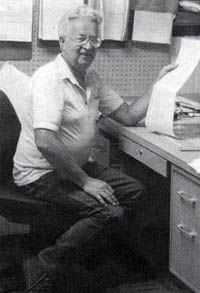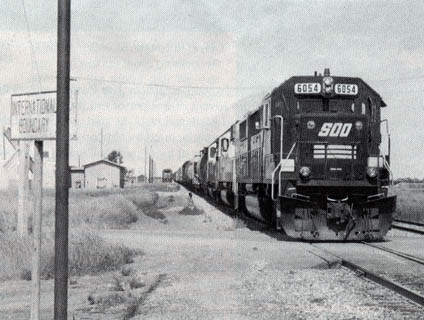
|
Vol. 22, No. 10
|
December 1992/January
1993
|
|
Riding the Rails
with Ken
Kraemer

Straight track between Moose Jaw and
Portal.
"As a CP Rail System News correspondent
for IFS-US, I decided the best way to get an idea of what the system looked like as a whole was to see
it in person. I decided that I would take two weeks to travel from Vancouver to Chicago, stopping at all the
important points along the way. In my first article, which appeared in the October issue, I talked about my trip from
Vancouver to Revelstoke. In the second stage, I travelled to Calgary - with a side trip to Mount Macdonald. Now for
the final led of my trip..."
Calgary seemed like a nice place. It was modern and it had the Blackfoot Truckstop Restaurant. In a few days I would
find myself fantasizing about a hamburger and fries at the Blackfoot.
Diesel Inspector Kevin Singleton picked me up at the bunkhouse early and we set out to tour some of the facilities.
Our first stop was at the Ogden Shops. The shops were closed for holidays and were undergoing maintenance and
improvement at the time, but as the railway's last major locomotive shop, they were impressive, nevertheless. Ogden
had rebuilt two D&H locomotives prior to my visit, and nearby I saw the D&H 7316, which was out of service
and had donated some parts to help rebuild the others.
Next, we went to the intermodal yard and met Terminal Operation Manager Jim Barr. The facility covers 7.2 hectares
(18 acres) and keeps three toplift loaders busy moving 1,000 trailers and containers per week.
Next, it was on to the Alyth diesel shop. The shop was assigned 263 road engines and 50 yard engines and serviced up
to 90 locomotives daily. The complex also included a locomotive wash station, a borite coolant recycling facility,
electronics lab, and a back shop area with drop pits and wheel and traction motor repair capabilities.
ON TO MOOSE JAW
Since the tour of Calgary had been going well and it was 688 km (430 miles) to Moose Jaw, I decided to head on to
Medicine Hat to lessen the distance a bit. I joined train 468 and crew members Conductor Eric Stephenson, Locomotive
Engineer Ray Walinga and Trainman John Terry.
After the excitement and spectacular scenery of the mountains, I was sort of dreading the long trip across the
Prairies, but a dramatic sky and bright yellow canola fields created a vista that rivaled the mountain scenery,
even though it was mostly flat.
Mr. Walinga said that he preferred the Prairie run to the westbound trip into the mountains because he liked the
faster run. I had to admit that it felt good to be rolling along at a steady 88 km/h (55 mph), but as the afternoon
progressed into evening, the view began to get a bit tedious.
The train crew assured me that I'd like Medicine Hat. "It's like and oasis on the old bald Prairie",
explained John Terry, and it was, with lots of trees, a nice little park along the river (with two CP Rail System
diesels in the old gray and maroon paint scheme on display), a distinctive station, and friendly downtown area.
Next morning, I boarded train 356, another empty grain train. No. 356 was running with only two units, one of which
was a slug. I decided to ride the caboose with Conductor Larry Meyers.
RIDING THE CABOOSE
Parts of the line between Calgary and Swift Current are not yet equipped with CTC so the conductor has to ride the
rear end to close the switches at the sidings.
At Swift Current, the line returned to CTC operations, so the crew rode the head end while I remained in the caboose.
I had been impressed by the way the crews called out their locations on the radio when passing stations and inspected
each other's trains at meets. Between Swift Current and Moose Jaw, crews of westbound trains kept reporting to the
head end of 356: "There's someone riding in your caboose." It made me feel a bit uncomfortable, but
it showed that they were really keeping an eye on things.
Assistant Superintendent Jim Russill met me on arrival at Moose Jaw, showed me around the facilities and took me to
see the big wooden moose at the edge of town.
Moose Jaw is one of the primary marshalling areas for the legions of grain trains that I had seen and ridden along
the way from Vancouver. Jim said that the yard would probably collect over 400 cars over the weekend and that they
had made up nine grain trains the previous week.
Next morning, I caught train 574, a mixed freight, crewed by Conductor Dale Braumberger, Locomotive Engineer Ken
Koshman, and Trainman Paul Duchuna.
The trip through the mountains out west needed to be described in grandiose superlatives. The line between Moose Jaw
and the U.S. border at Portal is best described in platitudes. From the town of Drinkwater to Weyburn, nearly 112 km
(70 miles), there are no curves - and no trees. there are a lot of wheat fields and a proportional number of grain
elevators.
We arrived at North Portal at 20:00 and after six hours of what seemed like sitting in a room staring at blank walls,
I was ready for a good supper. The problem was that there was only one restaurant in town, it was on the U.S. side
of the border and it was closed. After crossing to the U.S. side, I found a store that sold prepacked sandwiches and
the guys at the bunkhouse shared some of their food with me, so when I went to bed, at least I wasn't hungry.
The following morning, I took my bags and walked across the border to Portal, North Dakota, and the
Heavy Haul-U.S. portion of the CP Rail System - you probably remember it as the Soo Line.
The town of Portal is only 192 km (120 miles) from the geographic center of North America, so you can't really
describe it as the middle of nowhere, but it might be reasonable to say that it is just a dot on the face of the
continent, owing its existence to the railway and the highway border crossing.
There was a CP Rail System calendar on the wall of the local restaurant. It showed a D&H grain train which made
me feel a bit homesick. This was also where I found myself beginning to daydream about the Blackfoot Truckstop since
the food and service were on a par with the local scenery. No wonder the train crews carried all their own food.
| |

Floyd Swenson, chief clerk in Portal, restored my good
humor.
|
After breakfast, I went to the yard office where my mood was immediately brightened by Chief Clerk Floyd Swenson Jr.,
who had worked for the railway at Portal for 36 years and was of boundless good humor.
During my travels, I had heard stories that the famous gangster Al Capone used to hide out in Moose Jaw when things
got too hot in Chicago, travelling on the Soo Line-CP passenger train. Floyd said that he had heard
those stories too, and while he didn't know if they were true, he knew the area was a busy place during Prohibition.
He led me behind the station, which served as the customs office at the time. Scattered about in the cinders were
pieces of what must have been hundreds of broken bottles. Floyd said the customs agents used to smash the bottles
there when they were taken way from the would-be smugglers.

Train 570 crosses the border at
Portal.
I boarded train 570 that afternoon, heading for Minneapolis/St. Paul. I shared the cab of the second unit with
Trainman Jim Bienek. The rest of the crew consisted of Conductor Rich Fink, Locomotive Engineer Tom Felchle, and
Trainman Steve Ekert.
Although we were still crossing Prairie country, there was more activity to be seen from the train. Jim said it was
because, as we travelled further south, the crops were being harvested and elevators were being loaded with grain.
It was a long haul from Portal to St. Paul - 899 km (562 miles) - but my time was running short so I decided to stay
on Train 570 all the way.
On arrival in St. Paul, I contacted Dave Carlson and Tim Hedin from the communications department and Tim took me on
my last tour of the trip. Heading back to Minneapolis, we met Greg Jones, intermodal terminal manager at Shoreham
Yard, where we took a look at the intermodal operation there. The last stop of the day was at the CATS center to
talk to Assistant Manager Nancy Read.
I finished the trip to Chicago still on CP Rail System lines, aboard Amtrak's "Empire Builder". Signs of
change were all around. At Tunnel City, Wisconsin, crews were getting ready to enlarge the tunnel for
double-stack service and track and signal work was under way all along the route.
ONE ROAD "GOES ALL OVER"
While I was eating breakfast at the restaurant back in Portal, a tourist asked the waitress for a road map of North
Dakota. "You don't need a map of this state", replied the waitress. "We only have one road, and it
just goes all over".
One road that "just goes all over". That sounded like an apt description of CP Rail System.
I had travelled half way across the continent, starting out on the Canadian Pacific, and now I was finishing up
riding an Amtrak train on what, until recently, was called the Soo Line, which was actually track formerly owned by
the Milwaukee Road.
I felt like I had "gone all over" but I had only covered about 15 percent of CP Rail System's total
trackage.
This CP Rail News article is copyright
1993 by the Canadian Pacific Railway and is reprinted here with
their permission. All photographs, logos, and trademarks are the property of the Canadian Pacific Railway
Company.
|